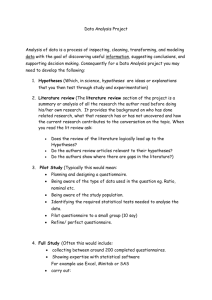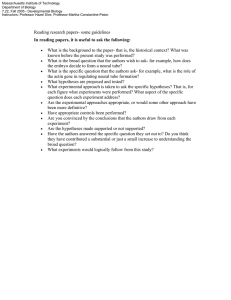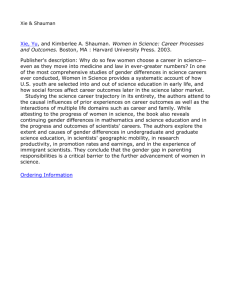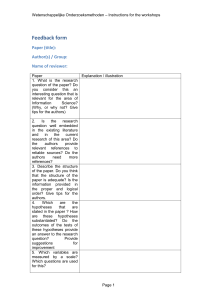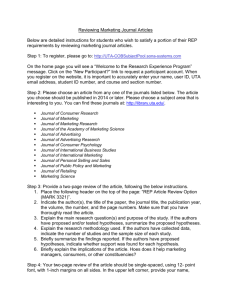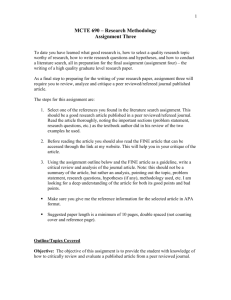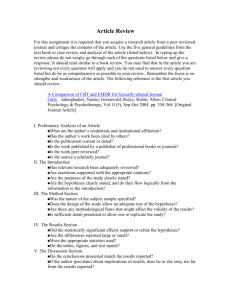304 Soc Sci Lab Asnm..
advertisement
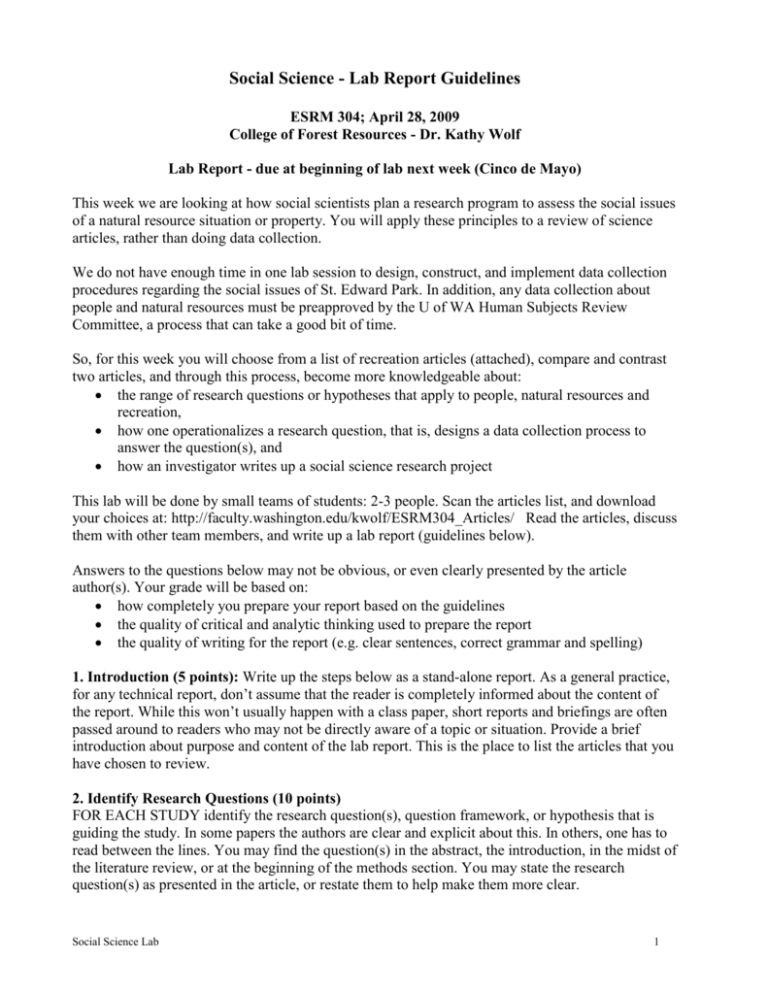
Social Science - Lab Report Guidelines ESRM 304; April 28, 2009 College of Forest Resources - Dr. Kathy Wolf Lab Report - due at beginning of lab next week (Cinco de Mayo) This week we are looking at how social scientists plan a research program to assess the social issues of a natural resource situation or property. You will apply these principles to a review of science articles, rather than doing data collection. We do not have enough time in one lab session to design, construct, and implement data collection procedures regarding the social issues of St. Edward Park. In addition, any data collection about people and natural resources must be preapproved by the U of WA Human Subjects Review Committee, a process that can take a good bit of time. So, for this week you will choose from a list of recreation articles (attached), compare and contrast two articles, and through this process, become more knowledgeable about: the range of research questions or hypotheses that apply to people, natural resources and recreation, how one operationalizes a research question, that is, designs a data collection process to answer the question(s), and how an investigator writes up a social science research project This lab will be done by small teams of students: 2-3 people. Scan the articles list, and download your choices at: http://faculty.washington.edu/kwolf/ESRM304_Articles/ Read the articles, discuss them with other team members, and write up a lab report (guidelines below). Answers to the questions below may not be obvious, or even clearly presented by the article author(s). Your grade will be based on: how completely you prepare your report based on the guidelines the quality of critical and analytic thinking used to prepare the report the quality of writing for the report (e.g. clear sentences, correct grammar and spelling) 1. Introduction (5 points): Write up the steps below as a stand-alone report. As a general practice, for any technical report, don’t assume that the reader is completely informed about the content of the report. While this won’t usually happen with a class paper, short reports and briefings are often passed around to readers who may not be directly aware of a topic or situation. Provide a brief introduction about purpose and content of the lab report. This is the place to list the articles that you have chosen to review. 2. Identify Research Questions (10 points) FOR EACH STUDY identify the research question(s), question framework, or hypothesis that is guiding the study. In some papers the authors are clear and explicit about this. In others, one has to read between the lines. You may find the question(s) in the abstract, the introduction, in the midst of the literature review, or at the beginning of the methods section. You may state the research question(s) as presented in the article, or restate them to help make them more clear. Social Science Lab 1 3. Study Sample (20 points) An important part of a social science project is to clearly describe WHO was selected to participate in the study and WHY the population is important. FOR EACH STUDY describe the population of interest for the study, including any personal attributes, geographic location, or other pertinent information. What is the relationship of the sample population to the land or place of interest in the study? Consider the research questions – was the study sample the most appropriate group of people to include in the study? 4. Methods (20 points) FOR EACH STUDY describe the data collection methods that were chosen. How was primary data collected – survey, interviews, observations, or? Remote sensing is being used more commonly for social research; was it used here? An investigator is rarely able to collect data from everyone in a chosen population; how was sampling done? What were the field protocols for data collection – recruiting, presenting or delivering an instrument, and follow-up process to make sure that an adequate response rate was achieved? Considering the research question(s) and the chosen sample population, do you think that the methods were appropriate? Propose one other method(s) approach that could be used to answer the research question(s)? 5. Data Analysis (5 points) The data analysis tools or techniques in the study may be more than the basic statistics that you have learned to date. The articles have been peer-reviewed so we’ll assume that the authors have used analytic methods correctly. Summarize the analysis and note any analysis outcomes that the authors call out or emphasize in their report. 6. Discussion and Conclusions (20 points) In this section a science article usually comes full circle, as the investigators describe if the tests and measures that they applied provided conclusive results. What did the results tell us about the questions or hypotheses? Again, some authors speak to this connection of question-method-results clearly. With others you have to dig in to find the interpretation. FOR EACH STUDY describe what knowledge was gained, and how this relates to the original research question(s) or hypotheses. 7. Compare and Contrast the Articles (20 points) You have read each of the articles carefully and in detail. At some time in your studies or career you may write a science study article. What have you learned about science presentation and description? In some disciplines science is published to be read by other scientists. In other disciplines science is written for a variety of audiences, including scientists, professionals, and resource managers. Who/what is the audience for each of the articles. Are the articles written clearly? Do they provide the appropriate level of detail without being too complex? Do you have any other comments about the science presentation? Lab Report Again, students will work in teams, and EACH TEAM will submit one report (put every person’s name on the paper). Each team’s Lab Report should be no more than 5 pages long (double spaced) and should contain each of the sections outlined above. The sections should be clearly called out using section headings, tables, etc. Social Science Lab 2

